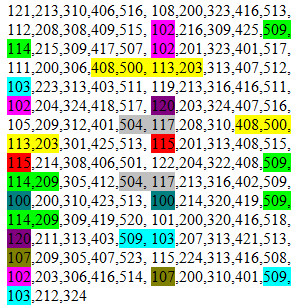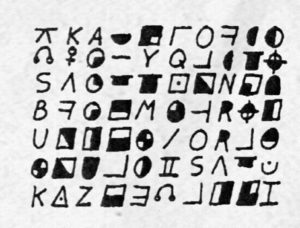The Voynich Manuscript’s zodiac roundel section has long frustrated researchers’ efforts to make sense of it at a high level, never mind determining what any specific zodiac nymph’s label means.
However, I can now see the outline of a new hypothesis that might explain what we’re seeing here…
A Stylistic Impasse?
The fact that each zodiac sign has thirty nymphs, thirty stars and thirty labels (all bar one?) would seem to be a good indication that some kind of per-degree astrology is going on here: and this is a lead I have pursued for many years.
The literature on this, from Pietro d’Abano to Andalo di Negro to (the as yet unseen) Volasfera, is uniformly Italian: so it would seem a relatively safe bet that the source of this section is also from that same Italian document tree.
At the same time, the observation that the drawings in the zodiac roundels are stylistically quite distinct from the rest of the Voynich Manuscript’s drawings has been made many times.
Combine this with the fourteenth century technological dating for the (unusual) Sagittarius crossbow, and you get loosely driven towards a working hypothesis that at least the central figures were copied from a (still unknown) late 14th century or early 15th century woodcut almanach, of the type that was most commonly found in Germany and Switzerland.
However, this leads to an awkward stylistic impasse: how can this zodiac section be both Italian and German at the same time?
Klebs and Martin
Back in 2009, I mentioned Arnold Klebs’ very interesting 1916 article on the history of balneology in the context of discussing Quire 13. However, there was another intriguing quote there that I only got round to chasing up a few days ago:
The yearly pilgrimages to the healing springs in the month of May, the baths of the women on St. John’s Day, which Petrarca describes so picturesquely in one of his letters from Cologne, were ancient survivals, indications of a deeply rooted love for and belief in the purifying powers of the liquid element. These seasonal wanderings to the healing springs were naturally brought into relation with astral conjunctions, a tendency soon exploited by the calendar makers and astrological physicians. Days and hours were set for bathing, blood-letting, cupping, and purging, carefully ascertained by the position of the stars. Martin in his book gives a great variety of such instances which offer interest from many points of view.
The author and book to whom Klebs is referring here is Alfred Martin and his immense (1906) “Deutsches Badewesen in vergangenen Tagen“, Jena : Diederichs. (The link is to archive.org .)
It turns out that Klebs sourced a great deal of his article from Martin’s labour of love (with its 159 illustrations and its 700-entry bibliography), which covers public baths, private baths, Jewish baths, bath-related legislation, mineral baths, bath architecture, bath technology, spas, saunas, and so forth, ranging from Roman times all the way up to 1900, and with a dominant focus on German and Swiss archival sources.
The Zodiac Bath Hypothesis
You can by now surely see where I’m heading with this: a zodiac bath hypothesis, where the Voynich’s zodiac section was in some way a copy of a German/Swiss original, which itself brought together the two traditions of per-degree astrology and good/bad times for “bathing, blood-letting, cupping, and purging” (as described by Klebs).
In some ways, this should be no surprise to anyone, given that the first few nymphs are all sitting in barrels, which were essentially what medieval private baths were (well, half-barrels, anyway).
And perhaps, in the context of clysters (enemas), it’s not inviting too much trouble to speculate what legs drawn apart / together might be representing. 🙂
The problem is that – probably because of my only fragmentary German – I can’t find any mention of “Days and hours were set for bathing, blood-letting, cupping, and purging, carefully ascertained by the position of the stars” in Martin’s German text.
I can see plenty of references to blood-letting (“aderlass”) etc, but pinning down the exact part that Klebs robbed out has proved to be beyond me.
Can I therefore please ask a favour of (one or more of) my German readers; which is simply to find the section in Alfred Martin’s book to which Krebs was referring? Thanks! 🙂
It would seem likely that this will then refer to a book in Martin’s capacious bibliography, at which point the game is (hopefully) afoot!


